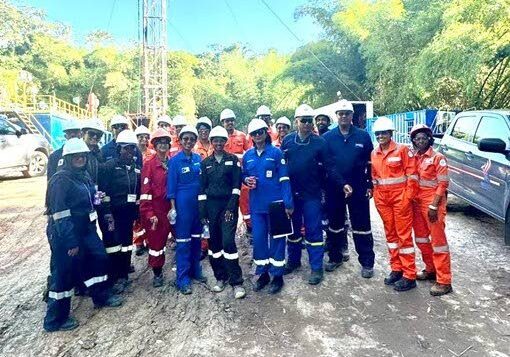A case for geotourism in Trinidad and Tobago

DANA TANKOO
Trinidad and Tobago has long been a pioneer in the global oil and gas industry, playing a pivotal role since the discovery of commercial oil in the Western Hemisphere in 1857.
The island nation’s rich geological history, combined with its active involvement in petroleum exploration, makes it an ideal location for geological field trips.
Scientists and students from around the world visit Trinidad to study its diverse geological features, which serve as analogues for formations found in other regions.
With ongoing collaborations between local universities and international institutions, Trinidad remains a hub for geological research, education and practical industry engagement.
The island's geological complexity – ranging from metamorphic rocks in the Northern Range to the sedimentary landscapes of the south – provides a comprehensive learning experience for those studying the Earth.
For over a century, Trinidad has served as a destination for scientists worldwide, offering unique opportunities to explore geological and biological features that are crucial not only to the oil and gas sector but also to various other industries.
Today, collaborations continue between UWI and institutions such as Dalhousie University in Canada and Anton de Kom University in Suriname.
Scientific societies, including the Geological Society of TT (GSTT) and the American Association of Petroleum Geologists Young Professionals (AAPGYP), have fostered strong ties with global academic institutions. This is largely due to the island’s accessible outcrops and its strong industry partnerships, which support both academic and practical geological research.
Visitors can easily observe and analyse geological formations by travelling to Mayaro, Cedros, San Fernando, or along the North Coast Road en route to Maracas Bay. These rock outcrops help geologists reconstruct the island's geological history, guiding assessments of hydrocarbon potential, mineral compositions for quarrying, engineering projects, and even disaster-management strategies.
Trinidad is recognised as having one of the most complex geologies in the world. The island provides a comprehensive view of all three major rock types: metamorphic rock in the Northern Range, a small section of igneous rock in Sans Souci, and vast sedimentary landscapes in Central and South Trinidad.
The extensive deformation caused by plate tectonic movements, combined with frequent construction and excavation in local northeastern quarries, allows field trip participants to examine massive hills of in-situ limestone, marl and granite.
As Trinidad straddles the Caribbean and South American tectonic plates, its structural geological processes remain active, with faulted and folded beds visible along roads such as the Lady Young and North Coast roads.
Additionally, the sedimentary influence from the Orinoco and Amazon deltas contributes to notable sedimentary features along the eastern and southern coastlines, playing a key role in petroleum exploration both locally and globally.
In January 2025, MSc students from the Anton de Kom University of Suriname, hosted by AAPGYP, had the opportunity not only to visit significant geological sites but also collaborate with onshore oil and quarry operators.
One of the highlights was the Batchasingh limestone quarry, where students gained deeper insights into carbonate reservoirs – an important feature for their work in Suriname, where the Demerara Plateau and offshore Suriname are known for carbonate reservoirs.
The trip also included a visit to Summit Energy Services Ltd Rig 10 at the Coora-2 block, giving them valuable exposure to drilling operations and Tubing-Conveyed Perforation tools displayed by Rigtech Services Ltd.
Additionally, Dalhousie University of Nova Scotia, Canada, has forged a strong partnership with the Petroleum Geoscience Department at UWI, St Augustine. Together, they organise an annual petroleum geoscience field trip that includes visits to several key locations.
Highlights include the Naparima Hill, the largest outcrop of TT's hydrocarbon source rock, and the Caroni Bird Sanctuary, where students observe a modern-day analogue for deltaic sedimentation and gain valuable insights into the biostratigraphy of geological exploration.
The GSTT and AAPGYP have become leaders in organising both day-long and week-long field trips, offering scientists and students invaluable opportunities to explore the country and gain hands-on experience that bridges academia and industry.
With its unique geological features and ongoing partnerships with global geological societies, TT is an increasingly sought-after destination for geoscientists worldwide. TT remains a key destination for geological field trips and geo-tourism.
The island offers unparalleled access to geological diversity, and through partnerships with government ministries, NGOs, and private businesses, Trinidad can foster meaningful collaborations between academia and industry.
TT also has great potential to position itself as a leading destination for geo-tourism – a niche form of sustainable tourism focused on geological features and their cultural and historical significance, with the potential to contribute significantly to foreign-exchange earnings, much like the country’s thriving eco-tourism sector. Geo-tourists can visit iconic sites such as the La Brea Pitch Lake, one of the world’s largest natural asphalt lakes, or explore the faulted and folded beds along the North Coast Road.
By integrating geo-tourism with the island’s rich cultural and ecological heritage – such as pairing geological site visits with excursions to the Caroni Bird Sanctuary, a great place to blend biological and geological – TT could attract eco-conscious travellers, geology enthusiasts, and students.
Promoting geo-tourism could also boost foreign exchange earnings as visitors from around the world come to experience the island’s geological wonders. This influx of visitors would support local economies, improve tourism infrastructure and foster sustainable development. By investing in infrastructure, training local guides, and promoting its geological significance internationally, TT has the opportunity to diversify its tourism offerings.
This approach not only showcases the island’s natural beauty and unique geological features but also drives sustainable economic growth, benefiting local communities and reinforcing the country's global standing as a leading destination for both geological research and eco-tourism.
Dana Tankoo is a petroleum geologist at Summit Energy Services Ltd, based in Fyzabad, South Trinidad.
She has a bachelors in geology from UWI, Mona Campus and an MBA in sustainable energy management from the Arthur Lok Jack School of Business.
This column was submitted by GSTT.

Comments
"A case for geotourism in Trinidad and Tobago"